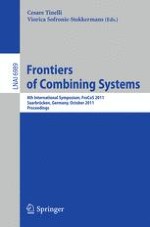2011 | Book
Frontiers of Combining Systems
8th International Symposium, FroCoS 2011, Saarbrücken, Germany, October 5-7, 2011. Proceedings
Editors: Cesare Tinelli, Viorica Sofronie-Stokkermans
Publisher: Springer Berlin Heidelberg
Book Series : Lecture Notes in Computer Science
